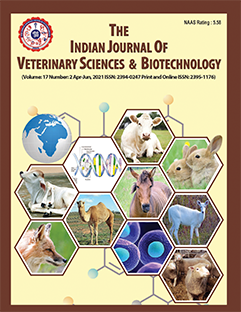Prevalence and Species Diversity of Eimeria in the Poultry of Chhattisgarh Plains
DOI:
https://doi.org/10.48165/ijvsbt.21.4.29Keywords:
Eimeria, Poultry, Morphometry, Prevalence, ChhattisgarhAbstract
The present study was undertaken to determine the prevalence of coccidia parasites in poultry across both organized and unorganized farms in four districts, namely Bilaspur, Durg, Korba and Rajnandgaon, located in the plain region of Chhattisgarh. The overall prevalence of poultry coccidiosis was found to be 17.5% (42/240), with organized farms showing an infection rate of 17.2% (31/180), while unorganized farms exhibited a slightly higher rate of 18.3% (11/60). The highest prevalence (40%) was recorded in unorganized farms of the Korba district. Morphometric analysis of the oocysts revealed the presence of mixed Eimeria infections in all sampled farms, with 3 to 6 species identified per location. The most prevalent species across the region were E. acervulina (93.75%), E. maxima (87.5%), E. mitis (87.5%) and E. tenella (81.25%), followed by E. necatrix (25.0%), E. praecox (12.5%) and E. brunetti (12.5%). These findings highlight the widespread nature of mixed Eimeria infections in both organized and unorganized poultry systems. Regular monitoring and region-specific control strategies are essential to minimize production losses due to coccidiosis in Chhattisgarh.
Downloads
References
1. Department of Animal Husbandry and Dairying. (2024). Annual Report 2024. Ministry of Fisheries, Animal Husbandry and Dairying, Government of India, New Delhi.
2. Jadhav, B.N., & Nikam, S.V. (2014). Study of Eimeria brunetti (Levine 1942) in broiler chicken from Aurangabad District of Maharashtra State India. International Journal of Applied Science Research and Review, 1(3), 102–106.
3. Jadhav, B.N., Nikam, S.V., & Bhamare, S.N. (2012). Eimerian infection is great challenge to poultry industry in Aurangabad district of Maharashtra, India. Elixir Applied Biology, 47, 8973–8976.
4. Jadhav, B.N., Nikam, S.V., Bhamre, S.N., & Jaid, E.L. (2011). Study of Eimeria necatrix in broiler chicken from Aurangabad District of Maharashtra state India. International Multidisciplinary Research Journal, 1(11), 11–12.
5. Jones, C. (2024). India Poultry Market 2024–2032: Comprehensive Analysis, Trends, Growth Projections and Key Players. Claight Corporation (Expert Market Research). Retrieved from www.expertmarketresearch.com
6. Kalita, A., Kakati, P., & Sarmah, P.C. (2021). Isolation and molecular identification of Eimeria species circulating in broiler chicken flocks of Assam (India). Haryana Veterinarian, 60(2), 251–254.
7. Levine, N.D. (1985). Veterinary Protozoology (1st ed.). Iowa State University Press, Ames, Iowa, USA, pp. 178–188.
8. Livestock Census. (2019). Basic Animal Husbandry Statistics. Department of Animal Husbandry, Dairying and Fisheries, Government of India, New Delhi. Retrieved from https://data.gov.in/catalog/20th-livestock-census
9. Mankani, P.G., Rajagopal, A., Devada, K., Priya, M.N., Sajitha, I.S., & Karthika, R. (2021). Occurrence of poultry coccidiosis in different management systems in Thrissur, Kerala. Journal of Veterinary and Animal Science, 52(3), 303–307.
10. Olufemi, A., Olatoye, I., Oladele, D., Adejimi, J.O., & Ogundipe, G.A.T. (2020). Morphometric and molecular identification of Eimeria species from commercial chickens in Nigeria. Journal of Dairy Veterinary and Animal Research, 9(4), 104–108.
11. Pal, S., & Sanyal, P.K. (2014). Essentials of Veterinary Parasitology (1st ed.). Kalyani Publishers, India, pp. 373–375.
12. Panda, D.N., Mishra, A., Misra, S.C., & Rao, A.G. (1999). Efficacy of ESB3 in the treatment of experimental Eimeria tenella infection in broiler chickens. Indian Veterinary Journal, 76, 199–201.
13. Pant, S., Bhatt, P., Shekhar, S., & Krishna, G. (2018). Epidemiological investigation of poultry coccidiosis in and around Tarai region of Uttarakhand. International Journal of Current Microbiology and Applied Sciences, 7(7), 374–380.
14. Raman, M., Dhinakarraj, G., Basith, S.A., & Gomathinayagam, G. (2012). Speciation of poultry Eimeria by morphometry and SCAR PCR in Southern India. The Indian Journal of Animal Sciences, 82(8), 805–811.
15. Salam, S.T., & Wani, S.A. (2021). Prevalence and pathology associated with coccidian parasite Eimeria tenella in organised and unorganised poultry of Kashmir Valley, India. Acta Scientific Microbiology, 4(4), 100–104.
16. Sharma, S., Iqbal, A., Azmi, S., Mushtaq, I., Wani, Z.A., & Ahmad, S. (2015). Prevalence of poultry coccidiosis in Jammu region of Jammu & Kashmir State. Journal of Parasitic Diseases, 39(1), 85–89.
17. Singh, M., Kaur, P., Singla, L.D., Kashyap, N., & Bal, M.S. (2021). Assessment of risk factors associated with prevalence of gastrointestinal parasites in poultry of central plain zone of Punjab, India. Veterinary World, 14(4), 972.
Downloads
Published
Issue
Section
License
Copyright (c) 2025 Indian Journal of Veterinary Sciences and Biotechnology

This work is licensed under a Creative Commons Attribution-NonCommercial-NoDerivatives 4.0 International License.




